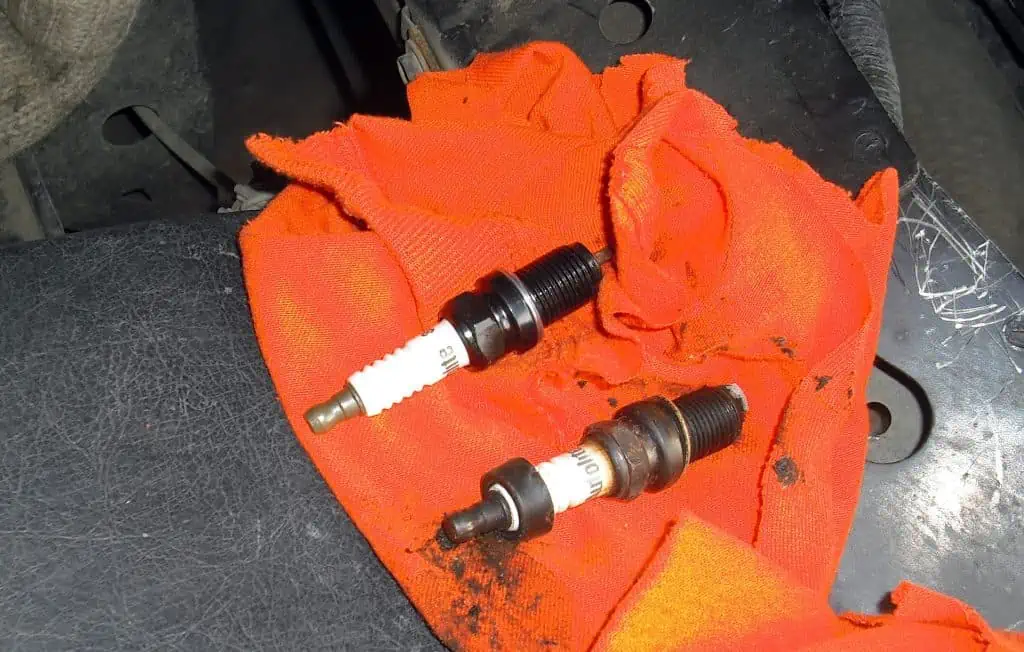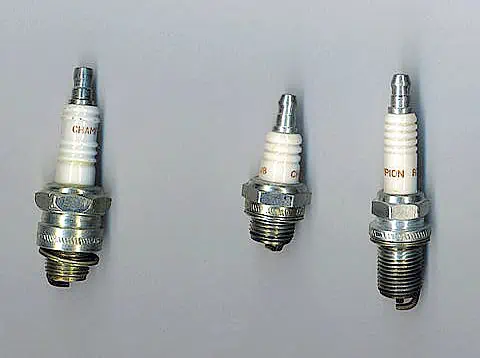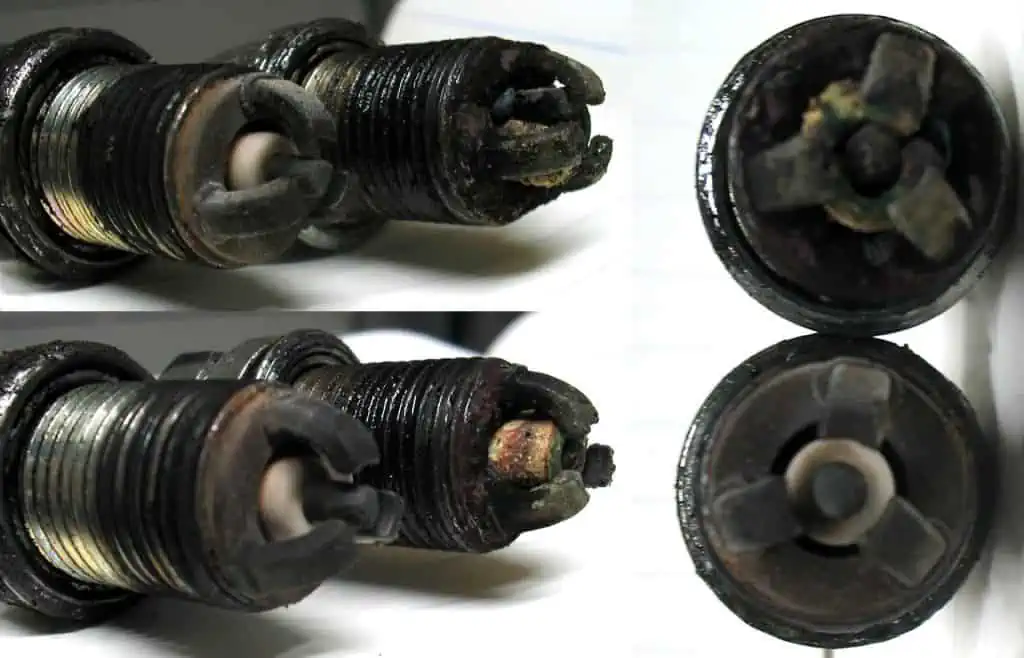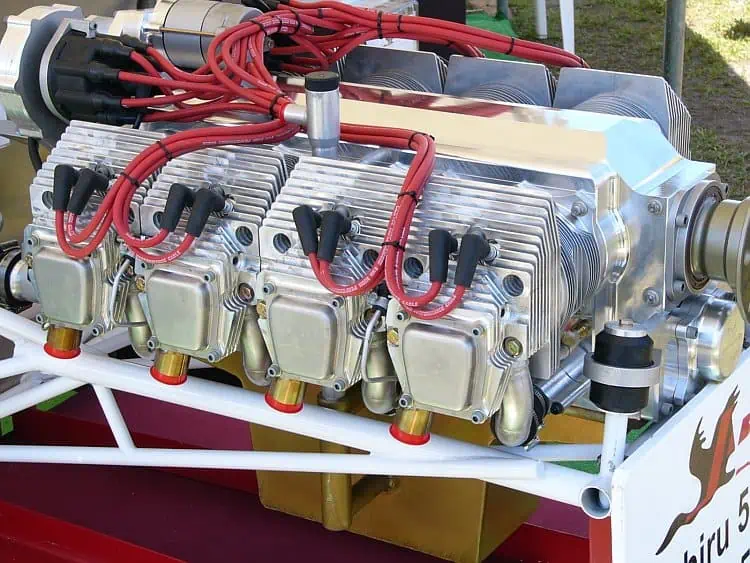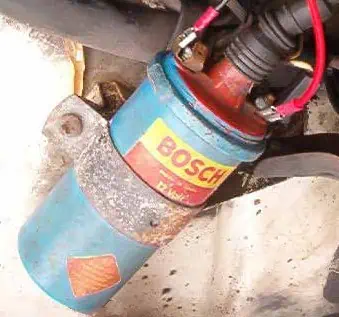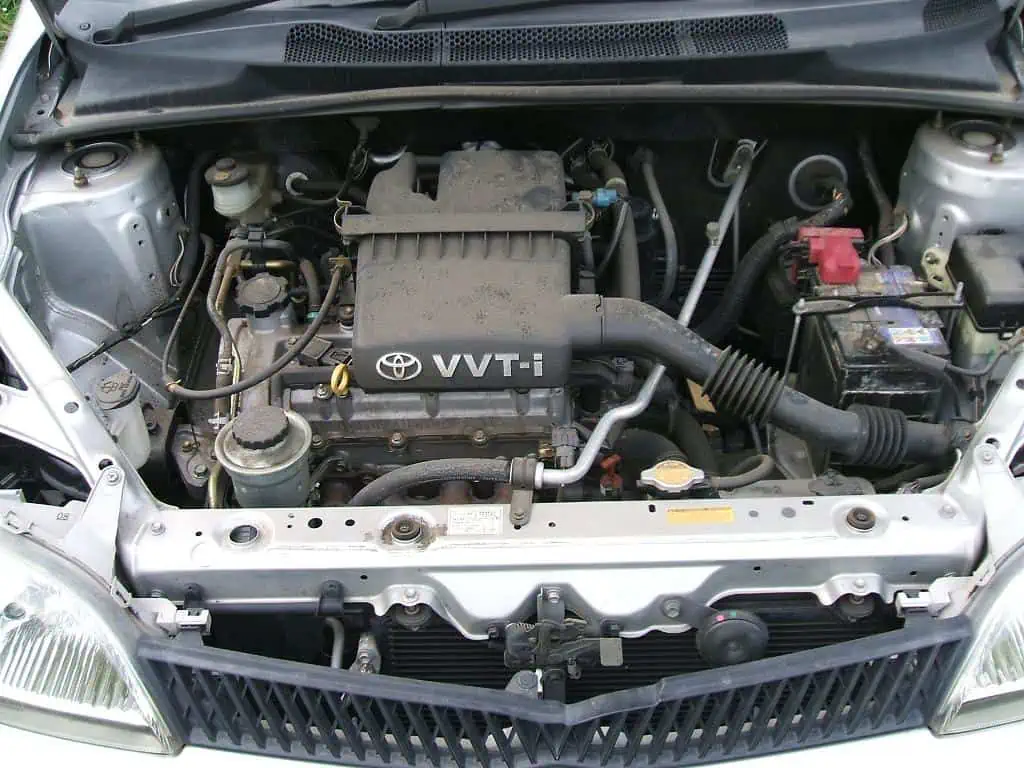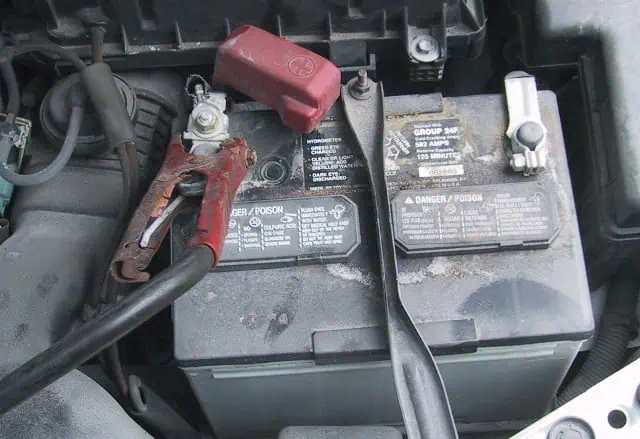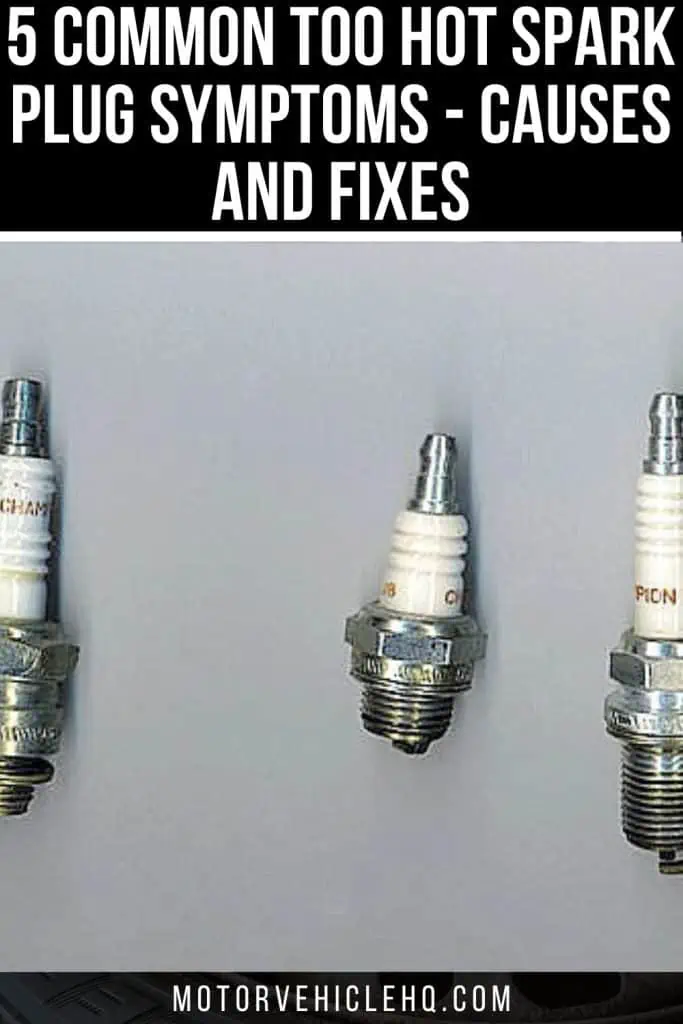It takes more than simply daily driving to be a car owner. It’s also crucial to comprehend how the various automotive components function. Minor or big problems can arise with cars frequently.
While some of these car issues require emergency garage visits, others may only require a simple owner’s diagnostic, which may save you a ton of money.
One of the least frequent issues with current autos is too hot spark plug symptoms. Due to this issue’s rarity, some motorists have a difficult time telling it apart from other auto problems.
The spark plug’s primary function is to produce the crucial spark required to turn on your car’s ignition. The spark plug will begin to wear out if it overheats, which will effectively cause damage and prevent the ignition of the combustion process.
If you want your car to run as efficiently as possible, you must maintain the spark plugs in it.
Yes, spark plugs can be harmed by overheating. The metal electrode in spark plugs may get broken or distorted as a result of thermal shock when exposed to temperatures that are too high. Engine misfiring and decreased performance may result from this.
Additionally, an inefficient spark and reduced fuel efficiency might result from an increase in the space between the electrodes. Maintaining the ideal engine temperature is crucial to prevent spark plug damage, so make sure that all of the coolant, hoses and fan belts are in good operating order.
Furthermore, it’s critical to frequently check spark plugs for deterioration and replace them as necessary.
Understanding the Heat Ranges of Spark Plugs
Do you know the thermal range of a spark plug, which is typically used to ignite compressed fuel/air mixtures? The description of spark plug heat range, how it impacts your engine, and proper usage are now provided to you to simplify things and help you understand that fundamental phrase.
The old spark plug was removed from a car, the new one is ready to install by Myke2020. The primary job of the spark plug is to provide the vital spark needed to turn on the ignition in your car. If the spark plug overheats, it will start to wear out, resulting in damage and preventing the ignition of the combustion process.
Let’s start by explaining the spark plug heat range in plain terms.
The Spark Plug Heat Range: What Is It?
The heat range of a spark plug is the rate at which heat may be transferred from the firing tip to the water jacket of the cylinder head and then into the cooling system. Spark plug heat ranges can change greatly from plug to plug and can be measured in a variety of ways, making brand comparisons challenging.
Your engine may undergo detonation, pre-ignition, or power loss, specifically, if the spark plug is excessively hot. The spark plug won’t be able to effectively burn off carbon buildup during self-cleaning if it is too cold. Therefore, for high-performance engines, selecting the appropriate thermal range is essential.
Manufacturers of spark plugs often advise that the tip temperature be kept between 500 and 850 degrees Celsius. Spark plug manufacturers do not all utilize the same thermal range numbering method. For Champion, Autolite, and Bosch, the higher the number, the hotter the plug. Other manufacturers’ numbering systems are the contrary. But with NGK, the colder the plug, the higher the number.
Hot and Cold Spark Plugs: What are They?
Every spark plug manufacturer uses a different number to designate the heat range. The typical temperature range for NGK Spark Plugs is 2 to 11. Spark plugs are frequently referred to as either hot spark plugs or cold spark plugs in general.
1. The Hot Spark Plug
A hot spark plug is one that progressively conducts heat from the firing tip into the engine head while maintaining a higher firing tip temperature. For spark plug symptoms, detonation (engine banging) or dissolving center electrodes are excessively hot. Applications that operate primarily at low RPMs benefit from hot plugs. Heat is transported from the firing tip to the cooling system more slowly with longer insulator nose lengths.
2. The Cold Spark Plug
A cold spark plug decreases the temperature of the spark plug tip by conducting more heat away from it. High rpm engines, forced induction applications, and other situations where the engine produces high operating temperatures are perfect candidates for cold plugs. The heat range of a spark plug refers to whether it is hot or cool.
A Hot Spark Plug vs. A Cold Spark Plug: What Distinguishes Them?
The temperature at which a hot and cold spark plug performs most effectively is the main distinction between the two. While cold spark plugs work best at temperatures between 400 and 550 °C, hot spark plugs are made to perform between 600 and 800 °C.
High-performance engines benefit greatly from using hot spark plugs because they provide a shorter, hotter spark that ignites the air/fuel mixture more quickly. Cold spark plugs are used in engines with lower compression ratios and in applications where it is more difficult to sustain higher temperatures, such as start/stop engines.
The air/fuel mixture needs more energy to ignite in colder temperatures.
To withstand the increased heat, the electrodes of a hot spark plug are normally shorter and wider, while those of a cold spark plug are often longer and narrower. Because of the wider space that is now possible between the electrodes, it takes more energy for the spark to cross it.
Different sizes of automotive spark plugs by Gzuckier / CC BY-SA 3.0. Your car’s fuel usage suddenly increasing is a certain sign that your spark plugs need to be replaced. When the spark plugs are not working properly, the gas mileage is significantly reduced.
What Occurs When the Heat Ranges are Too High or Too Low?
A Too High Heat Range
The impacts can still be harmful to your engine even though they aren’t as bad as having a plug with a too-low rating. Your engine may struggle or lose power if a spark plug’s temperature is too low because deposit build-up on the firing end might result in ignition spark loss.
A Too Low Heat Range
The spark plug will overheat and cause an anomalous ignition firing (pre-ignition), which can result in the melting of the spark plug electrodes as well as piston seizure and erosion. When the heat range is too low, it can be exceedingly harmful to your car’s engine.
The Rule’s Summary
- Low heat range or hot spark plugs for low-power engines
- High heat range or cold spark plugs for powerful engines
Basic Heat Range Recommendations
1. The Nitrous Oxide
The substance that raises cylinder temperatures is nitrous oxide. As a result, the plug needs a colder thermal range than the conventional plug.
2. The Methanol
In comparison to regular gasoline, methanol is thought to have a higher degree of octane, and methanol produces more thorough combustion. To transfer more heat from the combustion chamber, as a result, you might require a cooler plug.
3. Adjustments to the Air to Fuel Mixture
Lean air/fuel combinations increase operating and plug tip temperatures, which could lead to knock or pre-ignition. For leaner air/fuel mixes, a colder heat range should be used. You should choose a greater heat range for rich air/fuel mixes since they can cause the plug temperature to drop, causing carbon deposits to accumulate on the tip.
4. Extended Acceleration and/or Driving at High Speeds
High-rpm driving and frequent, prolonged acceleration increase combustion temperatures and typically call for a colder heat range.
5. Sophisticated Ignition Timing
In general, advanced ignition timing increases the temperature of the spark plug. For every 10° increase in ignition timing, NGK predicts an increase of between 70° and 100°. To prevent knock or pre-ignition, you might need to utilize a colder heat range.
6. More Compressed Ratio
Higher compression ratios result in hotter and more pressurized cylinders. Again, if you want to quickly move all of that excess heat to the cooling system, you might require a colder heat range.
The view of dirty spark plugs by A7N8X / CC BY-SA 3.0. An overly hot spark plug will dirty the electrodes. As a result, the sparking process is postponed. When your car has issues with fuel ignition in the combustion chamber, this peak is also compromised.
7. Turbocharging or Supercharging
The increased cylinder pressure and temperature caused by forced induction supercharging raise the risk of detonation. Depending on the precise application, you might need to choose an overstock heat range that is much colder.
NOTE: Before changing a spark plug, arm yourself with knowledge of the spark plug’s heat range to assist you to prevent significant auto damage. Follow our maintenance advice to better understand your vehicle and learn how to fix it when necessary.
Which are the Common Too Hot Spark Plug Symptoms?
These indications are obvious to seasoned automobile owners and drivers but may not be noticeable to new car club members.
Some of the too hot spark plug symptoms on your car are poor acceleration, a decrease in gas mileage, and somewhat harder starts.
The spark plug, or sparking plug as some people prefer to refer to it, is the mechanism in charge of supplying spark ignition to the combustion chamber.
Before being sent to the combustion chamber to ignite the fuel-air mixture, the spark is created in the ignition system as an electric current.
The entire mechanism makes it possible for the operation to be contained in the combustion chamber in addition to igniting the fuel. An excessive amount of combustion pressure would impede operations if unchecked.
A sequence of electrodes and insulators on the spark plug enables efficient ignition and spark delivery. It is a minor auto component, yet its significance in both simple processes like starting and sophisticated ones like fuel combustion cannot be denied.
Make sure the electrodes are in good condition and that the spark plugs are clean to get the most out of your engine. Spark plugs that are dirty or burned will negatively affect the performance and general health of your engine.
Running too hot is one of the most frequent causes of damaged spark plugs. If the spark plugs are operating at an excessive temperature, fast action is required to remedy the situation; else, the plugs risk becoming completely worthless.
It’s crucial to watch out for the too hot spark plug symptoms to avoid this. Even though the list is lengthy, knowing the few key signs should be sufficient. The following are some of the too hot spark plug symptoms to watch out for in the event of too hot spark plug problem:
1. More Fuel Is Consumed
A sudden spike in your car’s fuel consumption is a surefire indication that your spark plugs are broken. The gas mileage substantially decreases when the spark plugs are not operating as they should. However, before drawing a firm conclusion, you must watch out for more symptoms.
2. Acceleration Power Weakens
Electrodes become fouled by a too hot spark plug. The sparking process is consequently delayed as a result. The peak is also impacted when your car experiences problems with fuel ignition in the combustion chamber. Both the ignition and the performance will deteriorate with time.
Spark plugs are inserted into the spark plug hole by Ahunt. The spark plugs play an important role in the fuel-burning process. If they exhaust themselves, perhaps by operating at too high a temperature, the entire process will be affected. Because the plugs are in charge of igniting the mixture of fuel and air, the engine will suffer if their function is absent or negated.
Slow behavior may be caused by other auto issues, but when it is accompanied by other symptoms, it can be attributed to a too hot spark plug.
Knowing your car well enables you to recognize when performance is noticeably amiss. Check the car’s performance now and in the past, then.
3. Problematic Starts
Don’t immediately point the finger at the battery if your automobile won’t start; other factors are just as at fault. Are you aware that burned-out spark plugs can result in difficult starts? Until the anger consumes you, you will turn the ignition key.
Fuel that has burned powers the car. The spark plugs play a significant part in the process where the combustion develops. The fuel will not ignite if the spark plugs are not functioning as they should, and you will not move.
Therefore, the spark plugs may also be to blame for the hard starts, in addition to the battery or an empty tank. Before you dismiss this issue as a problem, keep in mind that it might also be an indication of other hidden auto issues that the dashboard can’t see.
4. Engine Misfires
The process of burning fuel depends heavily on the spark plugs. The entire process will be compromised if they burn out, possibly from operating at too high a temperature.
The engine will suffer if the plugs’ function is absent or negated because they are responsible for the igniting of the fuel and air combination.
The combustion process will be impacted if the plugs are not performing as planned. Misfires and other problems from this interaction should be viewed more as indicators than as outcomes.
5. A Rough Idle
Any jarring or vibrating sounds made while the engine is idle should make you concerned about your plugs. Drivers frequently ignore these noises and end up paying the price most of the time.
Make time to get the sparking plugs tested if you hear these noises; you could avoid spending a lot of money on repairs.
What Causes Too Hot Spark Plug Symptoms?
Overheating is the most dangerous consequence of choosing a heat range that is too hot. The electrodes will quickly wear out from overheating, which could result in pre-ignition.
Before the timed spark event happens, pre-ignition takes place when the air-fuel mixture is ignited by a hot object or location in the combustion chamber. Pre-ignition resulting from the overheated insulator ceramic can happen when the spark plug firing end (tip) temperature surpasses 800°C.
Pre-ignition will significantly increase the cylinder pressure and temperature, which could seriously and expensively harm the engine. Blistering on the ceramic insulator and/or melted electrodes may be discovered while examining a spark plug that has been subjected to overheating or pre-ignition.
According to a general rule, the tip temperature of identical spark plug types varies between heat ranges by around 70°C and 100°C. Some of the problems that can lead to too-hot spark plugs are listed below.
Bosch ignition coil by Sonett72. Advanced ignition timing raises the spark plug’s temperature. NGK forecasts an increase of between 70° and 100° for every 10° increase in ignition timing. You might need to choose a colder heat range to avoid knock or pre-ignition.
1. An Ineffective Advanced Ignition Timing
The consequences for your engine could be catastrophic if the advanced ignition timing is not carefully controlled. The spark plugs become too hot as a result of the potential temperature increase of 211°F caused by this problem. Have a professional handle the advanced ignition to avoid this.
2. Overly Rich Fuel Mixture
Temperatures may quickly increase and cause knocking or pre-ignition if the gasoline being burned in the combustion chamber is too rich.
You can fix the air-fuel ratio analyzer to save the situation. These gadgets range in price from $60 to $260 for a new unit.
3. A Too Hot Spark Plug Heat Range
Spark plugs will overheat at temperatures above 800 degrees Celsius, which frequently results in pre-ignition. The electrodes would frequently lose their effectiveness too rapidly, which could cause serious problems in the combustion chamber.
4. Low Coolant Levels
The engine’s surface temperature would start to overheat if the vehicle’s coolant supply was insufficient. Spark plugs would become overheated as a result of surface temperature warming, which is one of the main issues. Make sure there is enough coolant in your car; that would be the remedy.
5. Fuel Blend Burning at Higher Temperatures
Because gasoline quality varies from time to time, it’s possible to use a richer fuel combination on occasion for improved performance. The issue is that an engine could be overheated since a richer fuel mixture would burn at considerably higher temperatures. Additionally, an overheated engine could result in a greater surface temperature and overheated spark plugs.
6. Leaking Engine Oil
Supporting the vehicle’s efforts at lubrication is one of the key purposes for oil in your car. However, if your car’s cylinder walls or piston rings are worn out and there isn’t enough oil in them, you can find that the engine overheats on its own.
The spark plugs would also be impacted by the overheating in addition to the engine. It can cause the spark plugs to overheat, or it might go the other way and cause the spark plugs to become moist and refuse to function.
7. Overly High Turbo Pressure
Pressure is one of the key factors that frequently causes heat to be produced in the engine. One of the parts that may be changed to achieve the performance you want for your vehicle is the turbo. You can easily alter the turbo pressures. A substantial amount of overheating would result from excessive heat caused by too high of pressures.
8. Poor Quality Fuel
Most fuel providers work hard to provide you with the highest caliber fuel, which would improve performance and safeguard your car. However, poor gasoline quality frequently causes a lot of problems for your engine. Not only does it harm some engine parts, but it also always leads to overheating, which harms the spark plugs.
A typical car engine by Carolla / CC BY-SA 3.0. If the vehicle’s coolant supply is insufficient, the engine would begin to overheat. One of the key problems is that surface temperature rise would cause spark plugs to overheat.
9. Inadequate Plug Tightening
Always check to see that your car’s spark plugs are installed properly. Your car can experience problems if the spark plugs are not properly tightened since it could allow more additives to enter the engine. To achieve optimum overall performance, you must make sure the plugs are adequately tight.
Is Having Too Hot Spark Plug Symptoms Anything to Get Worried About?
Spark plugs are intended to warm up. You cannot get the ignition spark necessary to start your car if the spark plugs do not get hot.
When everything is in working condition and your car is performing as it should, The ideal firing end temperature for a spark plug is around 500 degrees celsius.
There are a few factors that could raise the temperature of some spark plugs and cause them to overheat, which would diminish their effectiveness and the spark they produce.
What Occurs If You Have Too Hot Spark Plug Symptoms?
Pre-ignition is one of the main problems that frequently occur if you realize that you have too hot spark plug symptoms. When the air/fuel mixture burns before the scheduled event, this is called pre-ignition.
The timed event is the moment when you start your car to get it moving. Before the car starts, you can also experience a few misfires.
When a vehicle is started with too hot spark plug symptoms, the electrodes inside the spark plug may not function as they should, which could result in further damage to the spark plugs.
Additionally, it would eventually result in excessive wear and tear, which frequently happened on the engine’s interior.
Additionally, the pre-ignition would increase engine pressure and cylinder temperature. When oil-related components start to malfunction and occasionally produce some type of flooding into the various cylinders, the consequence could be catastrophic and could result in flooding of the engine.
As you can see, while an overheated spark plug might not directly affect your car, some knock-on effects will undoubtedly disrupt and frequently damage some of the other parts.
While replacing a spark plug is inexpensive, rebuilding the engine’s parts can potentially cost thousands of dollars.
How Can Too Hot Spark Plug Symptoms Be Fixed?
Determine whether the too hot spark plug symptoms are what’s causing the issue as soon as possible. You might find dealing with this to be one of the most annoying things ever.
Finding the root cause is the best method to address the issue. If so, you might need to alter the fuel/air mixture as well as the other elements, such as the turbo pressures.
After you have addressed some of these problems, I advise either taking out the spark plugs and replacing them or thoroughly cleaning them before using them again.
Can a Too Hot Spark Plug Avert Fouling?
No, fouling won’t cease if a spark plug is “too hot.” When there is insufficient spark energy, which can be brought on by several things including an inaccurate air/fuel mixture, an erroneous valve timing, or an improper spark plug heat range for the engine, fouling occurs.
A typical car battery by Wtshymanski. If your car won’t start, don’t instantly blame the battery; there may be other causes as well. Are you aware that damaged spark plugs might make it difficult to start your vehicle? You’ll start the car and keep it running until the rage overcomes you.
Although a hotter spark plug won’t completely prevent fouling, it may boost the likelihood of successful combustion. Fouling needs to be eliminated, so the underlying causes must be found and fixed.
How Does a Too Hot Spark Plug Appear Like?
A too hot spark plug will typically appear a little bit darker than usual and may even have a burned or charred appearance. Heat-related discoloration of the spark plug’s end is another possibility; this can range in hue from very light gray to very dark brown.
Additionally, there can be carbon buildup and burning indicators in the vicinity of the sparking. Because of the heat and damage caused by the spark plug, the ceramic portion of the plug may crack. Finally, the heat may have damaged or shattered the thruster, leaving bits behind.
Does a Too Hot Spark Plug Risk Engine Damage?
The electrode insulators risk melting if the temperature increases too much. This has a high repair cost-prone pre-ignition or detonation potential.
Is It Possible to Drive with a Too Hot Spark Plug?
Depending on how severe the injury is. It won’t be feasible to drive if the damage is significant because the automobile won’t even start. However, it is advisable to keep the distance as short as possible if the car can drive to lessen the likelihood of pre-ignition.
Can You Get More Power from Cold Spark Plugs?
The power supply will be excellent whether the temperature is hot or cold as long as it is within the specified range. Therefore, it is essential to constantly choose spark plugs with higher heat resistance.
Why Do Spark Plugs Have Excessive Carbon Buildup?
The most frequent causes of excessive carbon buildup on spark plugs are an improper fuel-air mixture, improper ignition timing, and a defective spark plug. Unburned gasoline may leak from the engine and deposit on the spark plug if the air-fuel mixture is excessively high (more fuel than air).
An excessively lean air-fuel combination (more air than fuel) can result in incomplete combustion and spark plug deposits.
In terms of spark plug carbonization, ignition time is also crucial. Fuel may not be entirely consumed if the timing is incorrect and the spark plug ignites too early or too late, leading to deposits on the spark plug.
The spark plug itself is the final frequent cause of excessive carbon deposits. Incomplete fuel combustion may result from a worn-out spark plug or one with the incorrect thermal range, which will leave deposits on the spark plug.
Regular spark plug inspections are necessary to avoid excessive carbon buildup, as is making sure the air-fuel ratio and ignition timing are set correctly. Additionally, if the spark plug appears to be very carbon-coated, it needs to be changed out for a new one.
The Conclusion
Before the engine has to shut down due to a problem with this tiny device, drivers seldom ever discuss spark plugs and their issues.
It is essential to the fuel combustion process and lack of it causes an interruption that cannot be covered up.
Before consulting the mechanic, there are a few symptoms you should watch out for to assess the condition of your spark plugs.
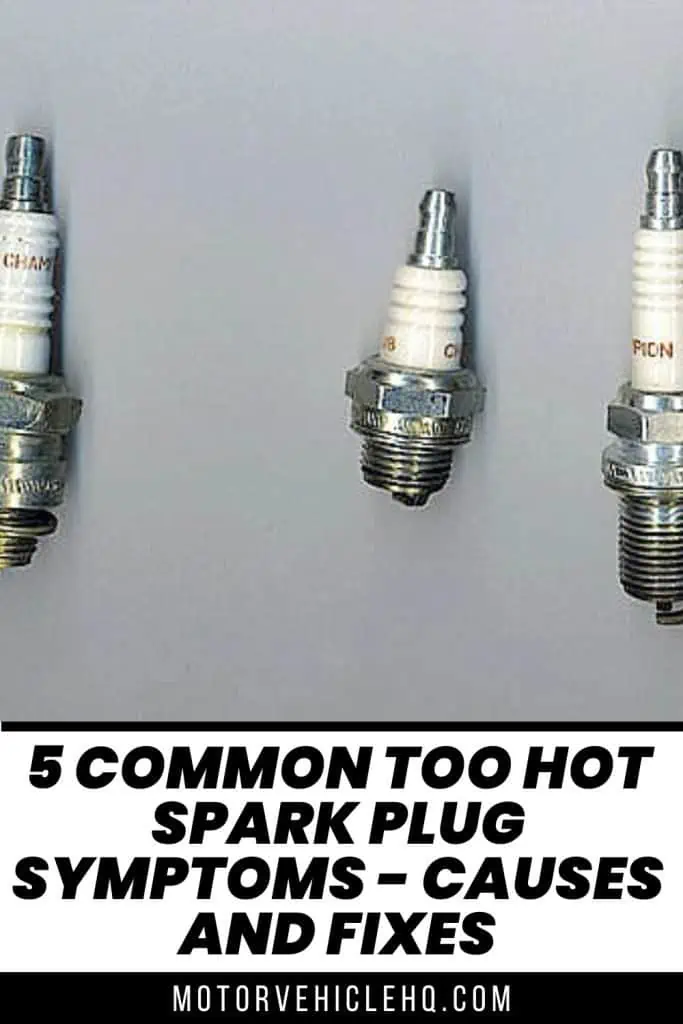
Different sizes of automotive spark plugs by Gzuckier / CC BY-SA 3.0

Jim Wicks is the founder of MotorVehicleHQ. With over two decades of experience in the automotive industry and a degree in Automotive Technology, Jim is a certified car expert who has worked in various roles ranging from a mechanic, car dealership manager, to a racing car driver. He has owned more than 20 cars over the past 15 years. Ask him about any vehicle you see on the road and he can tell you the make, model and year. He loves the aesthetics of all things cars, and keeps his vehicles in pristine condition.
In his free time, Jim enjoys getting his hands dirty under the hood of a classic car or taking long drives along the country roads. His favorite car? A 1967 Shelby GT500, a true classic that, according to Jim, “represents the pure essence of American muscle.”
